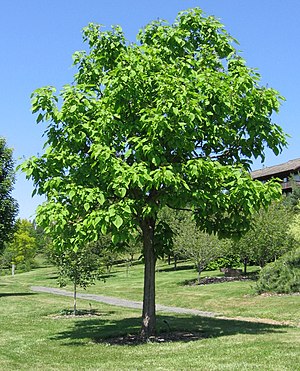Magnificent trumpet tree
| Magnificent trumpet tree | ||||||||||||
|---|---|---|---|---|---|---|---|---|---|---|---|---|

Magnificent Trumpet Tree ( Catalpa speciosa ) |
||||||||||||
| Systematics | ||||||||||||
|
||||||||||||
| Scientific name | ||||||||||||
| Catalpa speciosa | ||||||||||||
| ( Warder ex Barney) Engelm. |
The Magnificent catalpa ( Catalpa speciosa ) is a plant from the genus of the trumpet trees in the family of Bignoniaceae (Bignoniaceae). Its natural range extends along river and creek banks at the confluence of the Mississippi and Ohio Rivers . Its wood was used extensively during the transition to the 20th century for the manufacture of railway sleepers , which greatly reduced its stocks. It is not endangered due to its intensive budding capacity and can assert itself well against competing species in suitable locations.
description
The magnificent trumpet tree is a deciduous tree that, under favorable conditions, can reach a maximum height of 38 meters - usually less than 16 meters - and a trunk diameter ( BHD ) of 1.3 meters. In the open it forms rounded crowns with widely spreading branches.
The wood is porous and has a narrow, almost white sapwood and a light brown core . The bark of older trees is brown to slightly reddish, 2 to 2.5 centimeters thick and scaly.
The winter buds are chestnut brown and are enclosed by scales of buds lying on top of each other like roof tiles. Young shoots have a round cross-section and are reddish brown to purple in color and covered by numerous orange cork pores . The leaves are opposite or in whorls. The leaf blades are heart-shaped and are 15 to 30 inches long and 10 to 20 inches wide. They have an elongated tip and a slightly indented base. They have entire margins or have a few teeth. The upper side of the leaf is glabrous and dark green in color, the underside is lighter and hairy. The midrib stands out clearly. Dark glands can be present on it as well as on the vein corners. The stem is 10 to 15 centimeters long, strong and tomentose.
The flowers are in panicles 13 to 20 centimeters long and just as wide . The hermaphrodite flowers are zygomorphic , about 5 centimeters long and 6 centimeters in diameter. The crown is bell-shaped, five-lobed and white in color. The edges are clearly wavy. The ground is provided with red-brown and yellow bands and spots. The calyx is bilobed, hairy on the outside and of a purple color. Five stamens are formed, only two of which are fertile.
Capsules that are 20 to 50 centimeters long and 1.5 centimeters wide are formed as fruits. They are light brown when they are ripe in October and open on two flaps. Most of the fruit is shed before it is ripe and the reserve substances it contains benefit the remaining fruit. Each fruit contains numerous light brown seeds , 25 to 35 millimeters long and 5.5 to 8 millimeters wide , which are arranged in two to four rows and have two frayed wings.
The species germinates epigeously , the two cotyledons are deeply incised. The seedlings seem to have four cotyledons.
The number of chromosomes is 2n = 40.
Distribution and location requirements
The natural range is the alluvial land on river and stream banks in northern Illinois and Indiana , further in western Kentucky , in Tennessee , in the southeast of Missouri and in the northeast of Arkansas . The species was naturalized in some states in the southeastern United States. In many countries it is used as a park tree.
The Magnificent Trumpet Tree is a demanding forest tree of the temperate climate. The natural locations are among the best valley floors, they are deep and rich in nutrients. It is sensitive to early frost, but can withstand temperature extremes of −32 to +39 ° C when protected from the wind.
ecology
The magnificent trumpet tree is a forest tree that occurs together with the American sweetgum tree ( Liquidambar styraciflua ), the swamp oak ( Quercus palustris ) and Celtis laevigata , a representative of the hackberry trees .
use
At the beginning of the 20th century, apart from being used for railway sleepers, wood was mainly used for fence posts, roof shingles and masts. It shows a high level of durability, 30-year-old posts hardly show any traces of wood rot. Today the use of wood is no longer important, but the tree is planted as a park tree in many places.
swell
literature
- Schütt, Weisgerber, Schuck, Lang, Stimm, Roloff: Encyclopedia of Deciduous Trees . Nikol, Hamburg 2006, ISBN 3-937872-39-6 , pp. 195-201 .
Individual evidence
- ↑ a b Schütt et al .: Encyclopedia of Deciduous Trees . P. 196
- ↑ a b c d Schütt et al .: Encyclopedia of Deciduous Trees . P. 200
- ↑ a b Schütt et al .: Encyclopedia of Deciduous Trees . P. 197
- ↑ a b c Schütt et al .: Encyclopedia of Deciduous Trees . P. 198
- ↑ Schütt et al .: Encyclopedia of Deciduous Trees . Pp. 197-198
- ↑ Catalpa speciosa. In: Flora of Pakistan. www.efloras.org, p. 9 , accessed on June 21, 2009 (English).
- ↑ Schütt et al .: Encyclopedia of Deciduous Trees . P. 199



